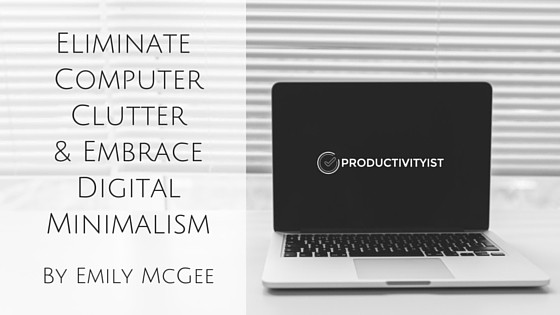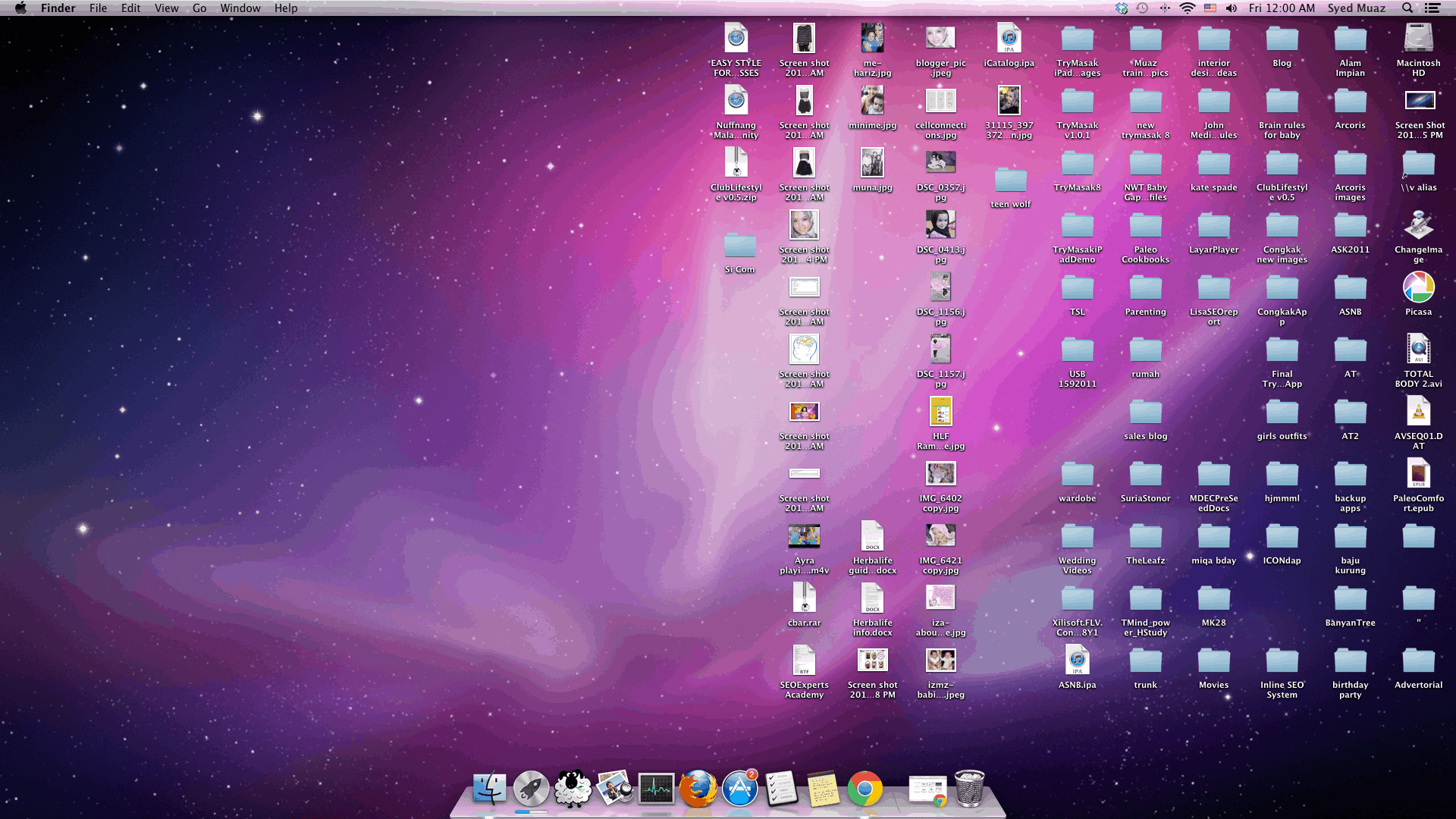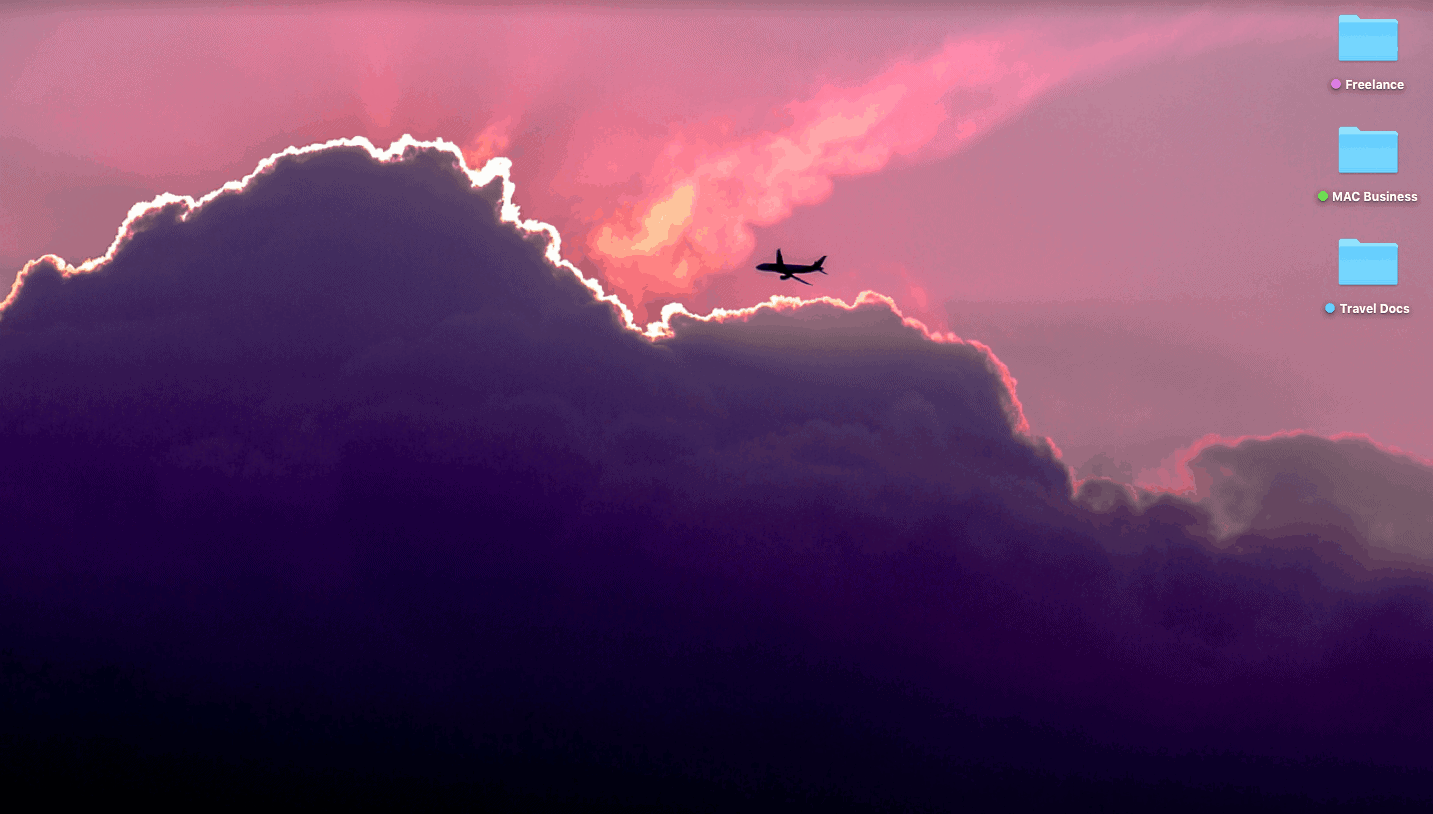
Today’s guest post is by Emily McGee. Her passion is in helping other freelancers learn how to grow their businesses without sacrificing work-life balance. You can connect with her on her website My Adaptable Career.
Raise your hand if you treat your computer desktop like a digital junk drawer.
I’m raising both of my hands right now.
Does your desktop look something like this?

Just looking at this desktop for a few moments wastes both time and valuable mental energy. It’s time to clean it up. Here’s why:
- You want to find everything you need quickly.
- You want to make it easy to put files away so you stay organized.
- You want to feel calm and in control when you look at your desktop, not overwhelmed and scattered.
We’re not going to a do a “Hollywood job” here. (FYI- According to my mother-in-law, a “Hollywood job” is when you shove everything into a closet before guests come over.)
If you want to see lasting benefits like increased productivity, less decision fatigue and more focus, you need to make big changes. I’m talking about applying minimalist principles to your desktop.
You need to simplify, and you need to be intentional. The plan is to delete files you no longer need, be intentional about the files you choose to keep, and then organize them in an intentional way.
Think “less is more.” The less digital junk you have, the more free time you’ll have.
Ready to tidy up your desktop? Let’s go.
Start by deleting.
If you want to make your desktop a haven of productivity instead of a junkyard, start by deleting. Deleting files is THE most important step. The less “stuff” you have on your computer, the easier it will be to stay organized. If you’re worried about deleting documents that you might need in the future, don’t be.
If you delete something that you need again, you can always recreate it or find it on the internet. Right now, I would guess that when you need a file that you rarely use, you spend a good 45 minutes looking for it, right? I know, I know, your computer has a search feature. But how often have you searched for a document and been unable to find it? Did you give it a vague file name? Do you have a dozen files with similar names? Did you put it in your Pocket account? Is it in Evernote? Is it in your documents folder? In your Google Drive?
When you get rid of most of your files, you can quickly figure out whether or not you have a specific document, and then move on. You’re in control. As a result, you save both time and frustration.
If you really can’t let go, then archive as many items as possible by moving them onto a flash drive or external hard drive. You’re still minimizing by getting rarely used documents off your computer.
Now that we’ve established why you need to delete files and why you shouldn’t worry about deleting something important, you can get to it.
Here’s how to clean up your files:
- Delete individual files on the desktop that you no longer need.
- Go through every folder on the desktop and delete unnecessary or duplicate files. Be ruthless. If you haven’t touched something in 6 months, and it’s not tax-related, consider deleting it.
- Open up your documents folder and delete individual files that you no longer need.
- In the documents folder, open up each folder and delete unnecessary or duplicate files. Keep being ruthless. I bet you’ve got all sorts of random files hiding away back here. Toss ‘em.
- If you are storing digital documents anywhere else on your hard drive, go there and repeat steps 1 and 2.
Organize your files.
After you’ve finished deleting as many files and folders as possible, it’s time to organize. Your ultimate goal is to make it easy to put documents AWAY. If it’s not easy to put a file away because you don’t have a place for it, or you can’t find the appropriate folder, or you have too many folders it could potentially fit into, then all your hard work is in vain.
So, as you start to organize your files, simplify as much as you can.
Here’s a simple way to do it:
1. Your goal should be to have the least number of folders possible. So make a list of must-have folders. I have 8 folders that I use: Freelance Work, Blog Work, Travel Documents, Taxes, Copies of Important Paperwork, Old/Archived Work Documents (from previous jobs, useful for my freelance portfolio), Photos, and Resume. I consolidated files from multiple folders into one new folder in order to minimize the number of total folders.
2. File every document into a folder. Each file should have a home. The only exception is a file you use every day, perhaps a timesheet or a list of all your passwords. Files that get daily use will stand out, in a good way, if you don’t put them in a folder. Consider using tags if you use a Mac or you can get a free app like Tabbles for Windows.
3. Open each folder and organize the sub-folders. I try to have just two layers of folder hierarchy because it’s easier to find what I need and easier to file documents away. The ONLY folder that goes deeper than that is my Old/Archived Work, which has 4 layers of folders.
4. Give each folder a short, clear name. Shoot for 2-3 words so that you have enough detail to know what’s in the folder, but you can still see the entire folder name on your document list or desktop.
5. If you use the documents in a folder every day, move that folder to your desktop. Keep all other folders in your Documents area.
Empty your downloads folder.
If like me, you’ve been hoarding documents in your download folder. It’s time to empty that bad boy out.
1. Go through your download folder. Drag any documents or files that you want to keep on to your desktop to file later. Remember that the goal is to minimize, so only keep things that you truly will use.
2. Delete everything left in your download folder. “Delete everything” might sound extreme. It’s not. If you have downloaded something, then it exists on the Internet and you can always go find it again if you really need it. Leaving hundreds of documents in your download folder just adds to the visual clutter and information overload on your computer. Delete everything. In the future, make a habit of deleting all your downloads at the end of the day, or at least once a week.
3. If you saved any downloaded documents, be sure to file those in the appropriate folder. This will help you stay organized and keep your downloads folder clean.
Find a great backdrop.
You’re being very intentional in choosing what files to keep and what to throw away. Apply that intentionality to finding a great backdrop for your computer. I recommend that you choose an image that either motivates/energizes you, or an image that calms/soothes you. Think about your personality and how you want to feel when you work on your computer. I know that sounds cheesy, but most of us spend hours each day looking at a computer screen. You might as well find something nice to look at. If you need inspiration, check out the photos at Unsplash. This website publishes photos under the Creative Commons Zero license, so you can use any photo for any purpose without providing attribution.
Empty the trashcan.
You’re almost done, but a good cleaning doesn’t end until the trashcan is empty. So, take a deep breath. Now click “Empty.”

This desktop features just three folders and each folder employs the use of tags. It’s like a mini-vacation for the eyes, isn’t it.
Now this is just the first step toward digital minimalism. If you want to build on your momentum since you’ve cleaned up your desktop and organized your files, let’s tackle your inbox and your social media accounts. You can sign up for my free 5-Day Digital Minimalism Challenge here.

